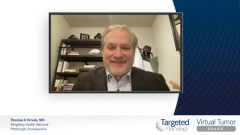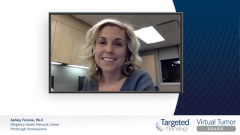
Case 1: Testing for BRCA Mutations and HRD in Advanced Ovarian Cancer
Cecelia H. Boardman, MD, John K. Chan, MD, and Ashley Farione, PA-C, discuss their treatment approach to genetic testing in patients with advanced ovarian cancer.
Episodes in this series

Thomas C. Krivak, MD: OK. For the panel, we went through the guidelines, we went through the different testing, and we talked about how important some of these tests are. To address some of these questions, Dr Boardman, what is your rational and how do you approach genetic testing in these patients with advanced-stage ovarian cancer?
Cecelia H. Boardman, MD: In my practice, what we do is we do germline testing immediately at diagnosis. I’m fortunate, I have a genetics counselor. He’s able to see the patient in the hospital post-operative day 2 and get germline testing going. That allows us to get that result quickly. Obviously, some third-party payors limit our timeframe in terms of somatic testing, and that may be delayed 2 to 4 weeks after hospital discharge. I at least get my germline going so that if that does come back positive, I already know in my mind that that patient is going to qualify for PARP inhibition either as a monotherapy or in combination depending on what my other clinical indicators are. I do both germline and somatic testing, and my argument for that is with germline testing, I think it’s important to know for the patient’s perspective what additional cancers they might be at risk for and how we shape their health care moving forward in terms of screening for breast cancer or colon cancer, and then I do somatic testing as part of a panel test because I’m also looking for other molecular markers for that patient in terms of not only her primary therapy, but also thinking about what we may use if she ever does develop a recurrence. I do both for all my patients.
Thomas C. Krivak, MD: John, how about yourself?
John K. Chan, MD: I do germline testing for all my patients with ovarian, peritoneal, and also fallopian tube cancer. In addition to that, I also order an HRD [homologous recombination deficiency] test for these patients upfront. Others in my practice also do reflex testing. If they test negative for germline, they reflex into the HRD test so that we can get access to different drugs for these patients, and also it provides some prognostic information for our patients. The patients who can get access to the single agent based on germline testing, these offer a significant benefit for our patients. For those patients who are HRD positive, that provides a lot of information because we can use dual therapy under PAOLA and use single-agent therapy with niraparib [Zejula] for these patients. Both of these tests provide significant information for us in the upfront setting, and it changes our upfront practice for these patients with respect to the options that we can offer these patients.
Thomas C. Krivak, MD: I’m curious, either Cecelia or John, the institutions that you’re at right now with your partners and your pathology partners, do you guys have protocols in place for how you’re going to do this, or do each of your partners do something similar but different? Do you feel like you’re capturing everybody that needs to be captured? How are your systems and you guys looking at that?
John K. Chan, MD: We don’t really have, let’s just say our health care system, at our institution that will capture all these patients. It’s mostly based on an individual practice basis, even in my office and how I practice and how my partner practices. There may be some variation to that with respect to how I design a workflow for my own practice and my own nurse and my MA [medical assistant] for all these patients who undergo surgery once they return to my office for post-op check. Because some of my patients may not have upfront debulking surgery, and all of our equipment and our kits for testing for germline and also our paperwork is based in our office. When they return for their 1-week post-op check, whether it’s from a biopsy for neoadjuvant chemotherapy or from an upfront surgery, we do their germline tests at that point and then submit the paperwork for somatic testing and/or for HRD testing during that visit. Within 2 weeks, even prior to them initiating first line of adjuvant therapy, they’re able to get benefits or you get to get results. Since many of the maintenance strategies are not needed until 4 months into their treatment, there’s not a significant delay.
Cecelia H. Boardman, MD: Similarly, to John, we do all our requests for testing from our office. We do not rely on our pathology partners to originate or process that request or do the insurance authorization. I have a gynecologic oncology nurse navigator, I’m under Sarah Cannon Research Institute, Nashville, Tennessee umbrella, so my navigator also helps to facilitate that bridge between our genetics counselor and the patient. I only have 1 partner and we are very consistent in our approach, there’s not a lot of discrepancy between what my partner and I do. I would say that I like to have that somatic and molecular profile information upfront, so I do get that, but then if that is negative in terms of germline and somatic BRCA, at least particularly before we’re able to get an LOH [loss of heterozygosity] score on the somatic platform that we use, then I would reflex out to HRD. We are trying to capture all of those patients who might be eligible for the PAOLA-1 regimen based on HRD status if they are then germline and somatic BRCA negative. We do reflex out to Myriad as a third step if needed.
Thomas C. Krivak, MD: That’s excellent. To me, it comes down to when should they be tested, and you guys are talking about all this. When I started doing this a couple of years ago, I completely agree, we’d do the germline and we knew what we’d want to do, and then I always thought that the somatic and the HRD would come after we get the germline. Sharing patients, having patients drive from all over central Pennsylvania, western Pennsylvania, I found myself thinking that I’d order the test and then we’re trying to make decisions with respect to maintenance therapy, sharing patients with medical oncology and realizing I hadn’t had a somatic BRCA or an HRD test and the germline may have been negative. When should patients be tested? I try to get everything upfront as well because just out of, I don’t want to say I thought I was doing it correctly, but I was finding that I didn’t have the information when I was trying to make decisions. I do an all-in approach upfront to make sure that we don’t miss anything. People in our office are similar, but different. Ashley works with me. Ashley, do you find as you work in the office with myself and the different doctors and working with the nurses, do you see any challenges with respect to how we’re ordering the tests or you think everything has been fairly smooth with people getting things upfront?
Ashley Farione, PA-C: No, it’s a pretty good system that we have in place. Usually, we’ll have them see genetics upfront. They’ll meet with them, and then from there they’ll undergo the germline testing. Then, I don’t know if it’s an AHN [Allegheny Health Network Center] protocol, I don’t know from genetics if they just send the pathology off, too, just for the somatic testing, because sometimes we will get the results of that. There are some cases, though, when we get the pathology back, and then you’ll say, oh, let’s send this out for additional testing or whatnot, and that would be more for a Myriad. But the system in our office is good. The nurses will take care of everything. The nurse navigators set everything up and we follow it to make sure that we’re getting the results. But there doesn’t seem to be a delay with anything. Everything comes back quickly, too, and it helps to direct the treatment that we’re going to do for the patients as well as cascade testing for the family.
Cecelia H. Boardman, MD: It’s important to realize that several years ago, we used to say, “Oh, it’s such a burden. We don’t want to put this additional burden. It creates guilt, and we should wait to do the genetic testing until they’ve completed their therapy because they’ve already got so much to deal with with a new cancer diagnosis and dealing with surgery and chemotherapy.” The way I counsel patients is that because we have directed therapeutics and the ability to respond to that genetic information, and because, as you said, Tom, it shapes their treatment plan from the cycle 1 or cycle 2, I always counsel my patients, you know, this is a lot and it is a lot to take in at once, but it’s important to have this information because it helps us design the best treatment and the most personalized treatment for you, to give you the opportunity for the best long-term outcome. I’ve shifted from doing testing after completion of primary chemotherapy to testing right at diagnosis.
Transcript Edited for Clarity












































